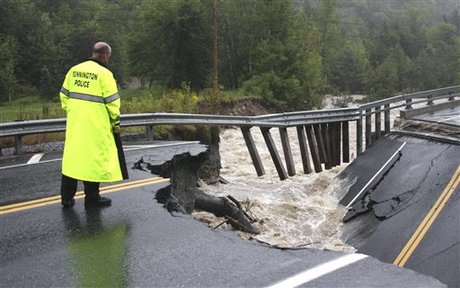Irene Moves to Canada after Killing 29 in U.S.
إقرأ هذا الخبر بالعربية
The state of Vermont on Monday battled historic flooding that swamped town centers as the United States limped back to normal from Hurricane Irene, blamed for at least 29 deaths.
Major cities including New York took unprecedented evacuation measures and were largely spared the full wrath of Hurricane Irene, which was downgraded on Sunday to a tropical storm as it drenched a vast stretch of the U.S. East Coast.
But the storm whose trail of destruction started a week ago in the Caribbean refused to go out with a whimper, ravaging virtually the entire state of Vermont before crossing into Canada where it also caused damage.
"The effects are still being felt in the country in New England and states like Vermont where there is an enormous amount of flooding," President Barack Obama said at the White House.
"The response continues, but I will make sure that FEMA and the other agencies are doing everything in their power to help the people on the ground," said Obama, referring to the Federal Emergency Management Agency.
Vermont authorities said the flooding may be the worst in the mountainous state since 1927. Offices were closed including in the capital Montpelier, where water levels began to recede Monday morning.
"We are in uncharted territory," said Joe Kraus of the Central Vermont Public Service. "In many places, we can't even get to the damage."
"It is impossible to say how long it will take to restore power to all customers, but many areas are totally inaccessible, roads are gone, and in some cases, it could take weeks."
A 21-year-old woman was presumed dead in Vermont after she joined her boyfriend in watching the rising waters of the Deerfield River on Sunday and was swept away.
Emergency officials and local media reported at least 29 deaths in nine eastern U.S. states, with six deaths each in New York state, North Carolina and Pennsylvania.
The youngest fatalities were a boy killed by a falling tree in his apartment in Newport News, a city on a coastal peninsula in Virginia, and a girl who died in North Carolina.
New York newspapers linked six deaths to Irene, including a man who was electrocuted as he tried to save a child who had gone into a flooded street with downed wires. The child was in serious condition.
In Canada, a man was swept away in Yamaska, about 105 kilometers northeast of Montreal, after two cars plunged into a chasm created when a road washed out, Quebec police spokesman Eric Benoit said.
The hurricane earlier last week killed at least five people in the Caribbean -- two each in the Dominican Republic and Haiti and one in the U.S. territory of Puerto Rico.
But the hurricane was not as severe as some people had prepared for. Wall Street rallied Monday in part on relief of limited damage to the infrastructure of the world's largest economy.
New York's subway, which was closed down Saturday in an unprecedented act of caution, reopened Monday morning, although suburban trains connecting suburbs in New Jersey, Connecticut and New York's Westchester County were suspended.
National rail operator Amtrak also experienced major disruptions, with major lines shut down north of Philadelphia as crews cleared up debris and inspected the tracks. New York's airports reopened, but with delays.
Eqecat Inc., a catastrophic risk management firm, estimated that damage to the eastern United States from the hurricane could reach up to $7 billion.
Morgan Stanley nonetheless said that Irene would likely rank among the costliest 10 hurricanes in U.S. history.



